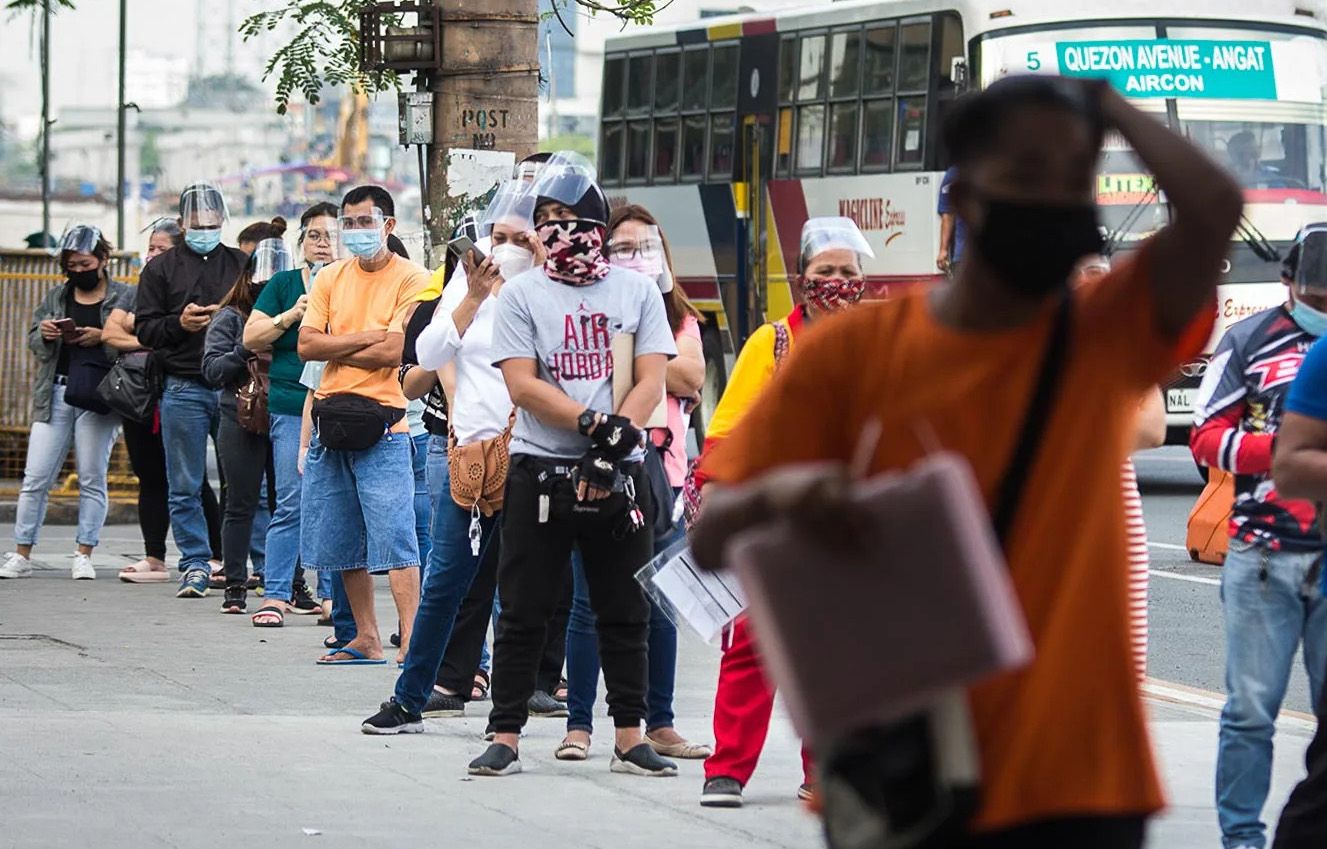
by Social Weather Stations
- Those worried somewhat or a great deal about catching COVID-19 remain at 88%
The Social Weather Survey of April 19-27, 2022, the most recent quarterly national survey finalized by SWS, found a record-high 83% of adult Filipinos hopeful that “the worst is behind us” with the COVID-19 crisis.
This is 3 points above the previous record of 80% in December 2021, and nearly twice as high as the 44% when SWS first asked the question in May 2020 [Chart 1].
On the other hand, those fearing “the worst is yet to come” fell from 19% in December 2021 to 16% in April 2022.
Worry about catching COVID-19 remains at 88%
The April 2022 survey also found 88% a great deal/somewhat worried (74% a great deal worried, 14% somewhat worried) and 12% a little worried/not worried (4% a little worried, 8% not worried) that anyone in their immediate family might catch COVID-19 [Chart 2].
This is similar to the 88% (72% a great deal worried, 16% somewhat worried) in December 2021, but 3 points below the 91% (76% a great deal worried, 15% somewhat worried) in September 2021.
Compared to past SWS surveys, worry about catching COVID-19 is much greater than worries about catching previous viruses such as Ebola, Swine Flu, Bird Flu, and Severe Acute Respiratory Syndrome (SARS).
“The worst is behind us” rises in Visayas and Mindanao
The April 2022 percentage of those saying “the worst is behind us” with the COVID-19 crisis is highest in Mindanao (86%), followed by Metro Manila (82%), Balance Luzon (82%), and the Visayas (81%) [Chart 3].
Compared to December 2021, those saying “the worst is behind us” rose by 3 points from 83% in Mindanao, and by 6 points from 75% in the Visayas. It stayed at 82% in Metro Manila, while it hardly moved from 81% in Balance Luzon.
On the other hand, the percentage of those fearing “the worst is yet to come” is slightly higher in the Visayas (18%), Balance Luzon (18%), and Metro Manila (17%) than in Mindanao (12%).
Compared to December 2021, those saying “the worst is yet to come” fell by 6 points from 24% in the Visayas, and by 5 points from 17% in Mindanao. It hardly moved from 17% in Balance Luzon and 18% in Metro Manila.
“The worst is behind us” is highest among non-elementary graduates
The percentage of those saying “the worst is behind us” is highest among those who either had no formal education or some elementary education (or non-elementary graduates) (86%), followed by those who either finished elementary or had some high school education (or elementary graduates) (83%), those who either finished junior high school, had some vocational schooling, had some senior high school, finished senior high school, completed vocational school, or attended some college (or junior high school graduates) (82%), and those who either graduated from college or took post-graduate studies (or college graduates) (80%) [Chart 4].
Compared to December 2021, those saying “the worst is behind us” rose by 14 points from 72% among non-elementary graduates. It stayed at 83% among elementary graduates and 80% among college graduates, while it hardly changed from 81% among junior high school graduates.
On the other hand, the percentage of those fearing “the worst is yet to come” rises with education: it was highest among college graduates (18%), followed by junior high school graduates (17%), elementary graduates (16%), and non-elementary graduates (14%).
Compared to December 2021, the percentage of those saying “the worst is yet to come” fell by 12 points from 26% among non-elementary graduates. It stayed at 16% among non-elementary graduates, while it hardly moved from 18% among junior high school graduates and 19% among college graduates.
Worry about catching COVID-19 eases in Metro Manila, but stays high elsewhere
The percentage of those a great deal/somewhat worried about catching COVID-19 is highest in the Visayas (94%), followed by Mindanao (93%), Balance Luzon (85%), and Metro Manila (83%) [Chart 5].
Compared to December 2021, worry about catching COVID-19 fell by 4 points from 87% in Metro Manila. However, it stayed at 94% in the Visayas, while it hardly moved from 91% in Mindanao and 84% in Balance Luzon.
Worry about catching COVID-19 rises among non-elementary graduates and college graduates
Those worried about catching COVID-19 are higher among college graduates (94%), non-elementary graduates (91%), and elementary graduates (89%) than among junior high school graduates (86%) [Chart 6].
Compared to December 2021, worry about catching COVID-19 fell from 90% among junior high school graduates and 91% among elementary graduates. However, it rose from 83% among college graduates and 82% among non-elementary graduates.
Worry of Filipinos about COVID-19 infection is always greater than that of Americans
Filipinos have always been more worried than Americans about catching COVID-19.
The Gallup April 25-May 1, 2022 survey found 31% of adult Americans worried (5% very worried, 26% somewhat worried) about getting the coronavirus, down from 34% in February 2022 and 50% in January 2022 [Chart 7].
Nevertheless, when it comes to catching COVID-19, the proportion of worried Americans was always lower than worried Filipinos.
Survey background
The First Quarter 2022 Social Weather Survey was conducted from April 19-27, 2022, using face-to-face interviews of 1,440 adults (18 years old and above) nationwide: 360 each in Balance Luzon, Metro Manila, the Visayas, and Mindanao. Face-to-face is the standard interviewing method for Social Weather Stations; the only exceptions were early in the pandemic when movement restrictions made face-to-face impossible and mobile phone interviews were conducted. Normal face-to-face field operations resumed in November 2020. The sampling error margins are ±2.6% for national percentages and ±5.2% for Balance Luzon, Metro Manila, the Visayas, and Mindanao.
The area estimates were weighted by the Philippine Statistics Authority medium-population projections for 2022 to obtain the national estimates.
The survey items reported here were non-commissioned. They were included at SWS’s initiative and released as a public service.
The exact phrasing of the survey questions (the source language is Filipino; English translation included) was:
“Alin po sa mga ito ang mas naglalarawan sa inyong nararamdaman tungkol sa krisis sa COVID-19 sa Pilipinas? Sa tingin po ninyo… LUMIPAS NA ANG PINAKAMALALA o MAS LALALÁ PA ITO? (ROTATE OPTIONS) [Which of the following best describes your feelings about the COVID-19 crisis in the Philippines? Do you think… the worst is behind us or the worst is yet to come?]
"Kayo po ba ay nababahala o hindi nababahala na kayo o sino man sa inyong pamilya ay MAGKASAKIT ng COVID-19? Kayo po ba ay… (READ OUT)? (LUBOS NA NABABAHALA, MEDYO NABABAHALA, NABABAHALA NANG KAUNTI, o HINDI NABABAHALA) [Are you worried or not worried that you or someone in your immediate family might CATCH COVID-19? Are you… (READ OUT)? (WORRIED A GREAT DEAL, SOMEWHAT WORRIED, WORRIED A LITTLE, or NOT WORRIED)].”
SWS employs its own staff for questionnaire design, sampling, fieldwork, data processing, and analysis, and does not outsource any of its survey operations. This report was prepared by Fernel Ted Paguinto, Joshua Deguito, and Leo Laroza.
Chart 1
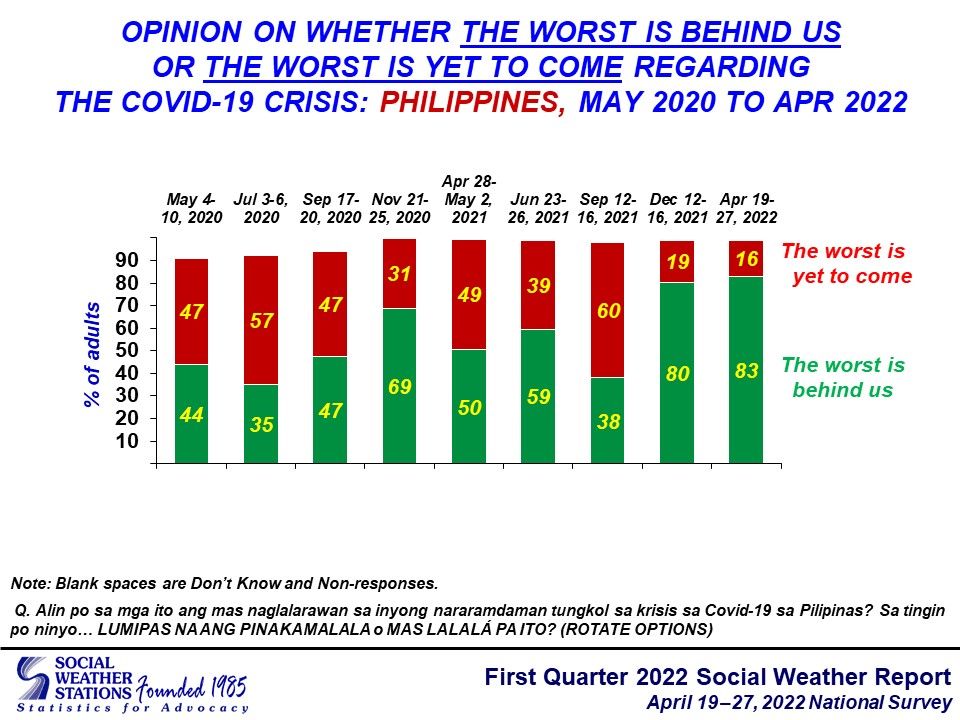
Chart 2
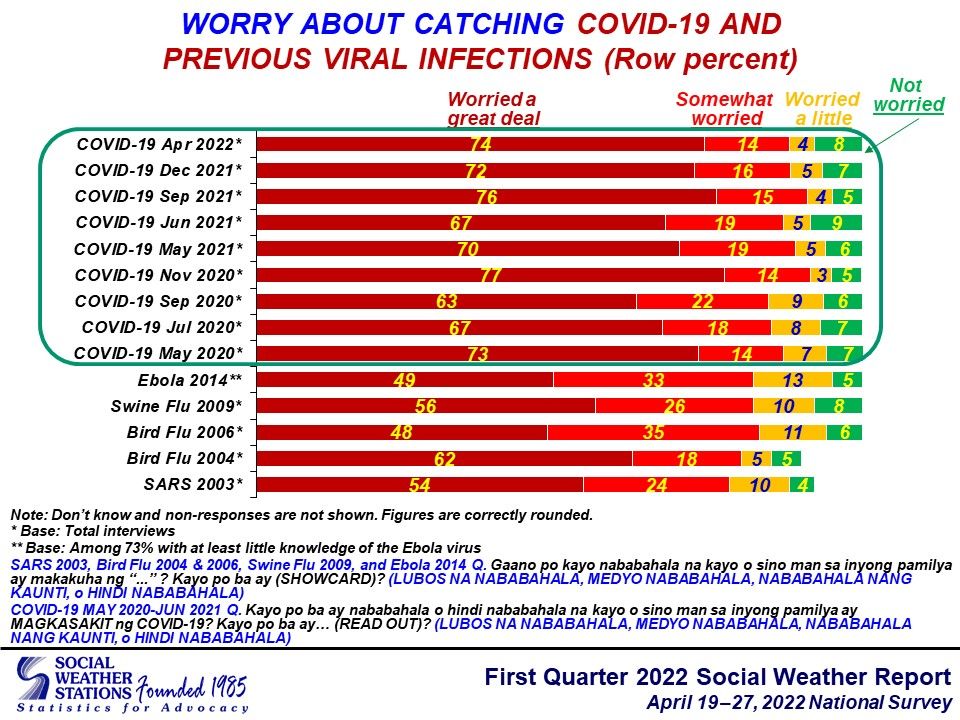
Chart 3
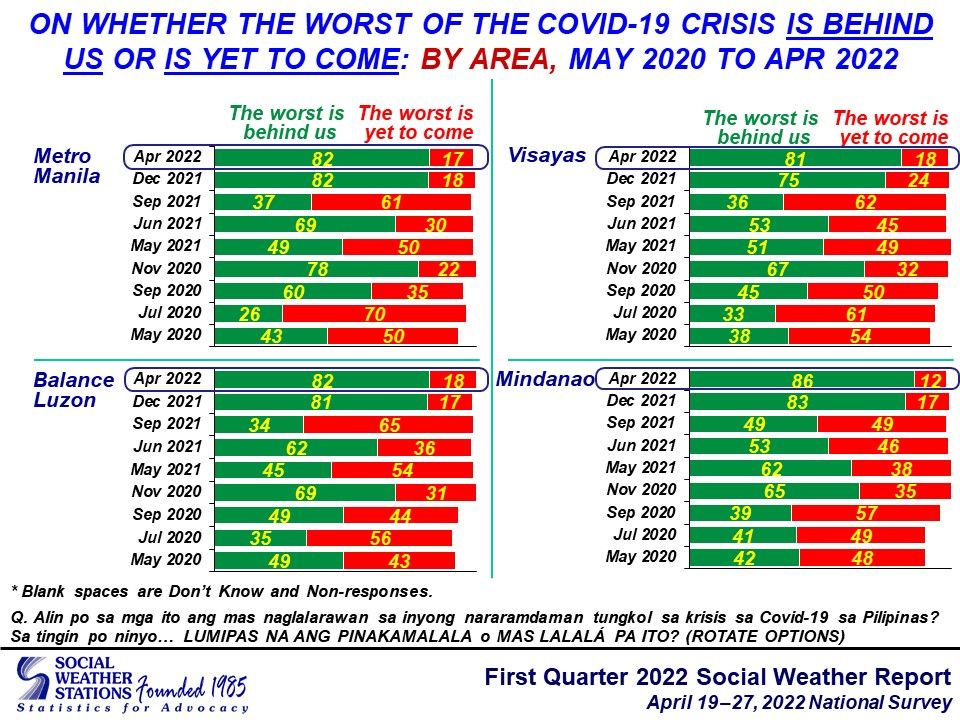
Chart 4
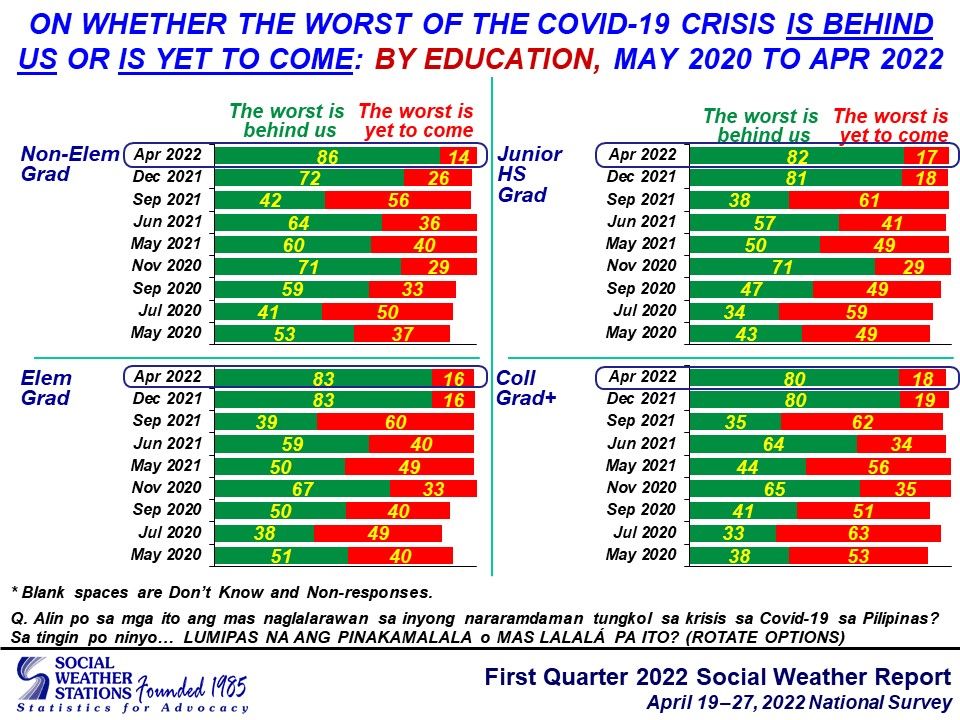
Chart 5
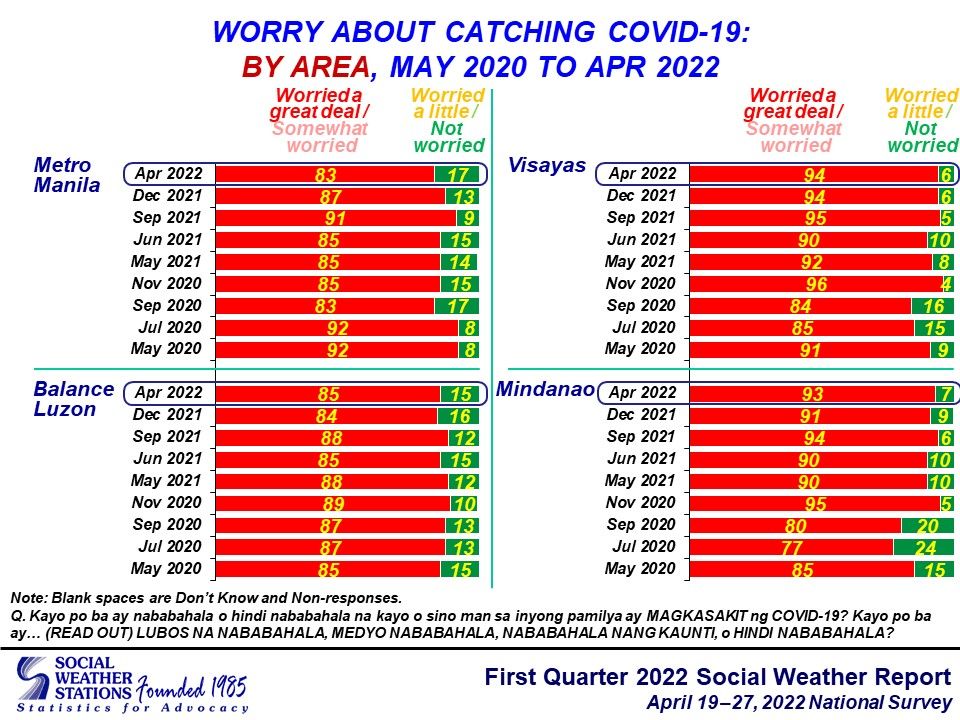
Chart 6
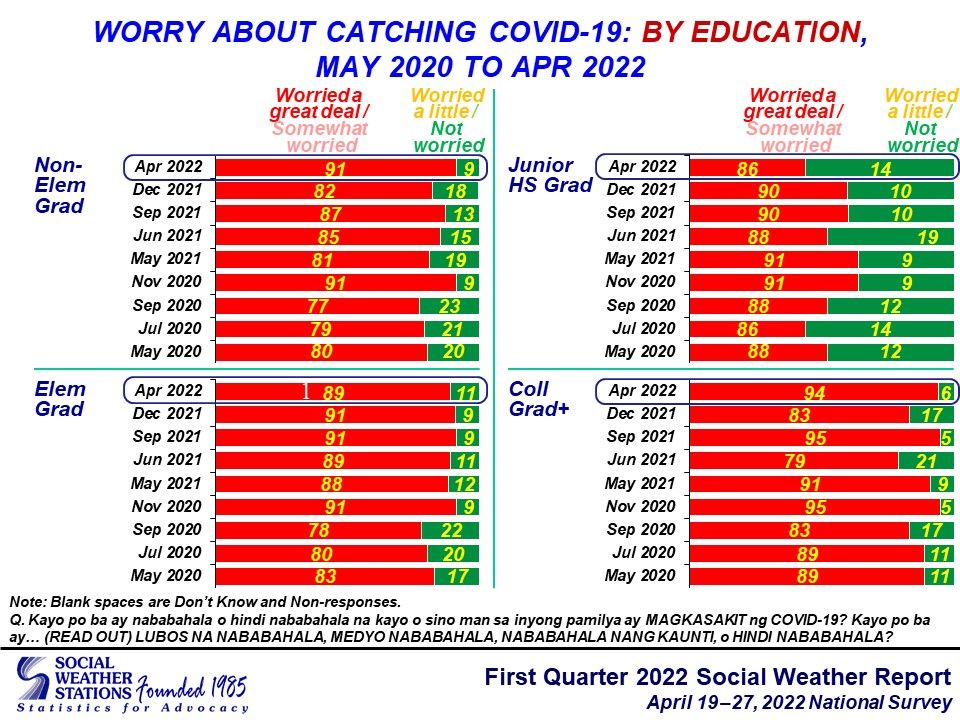
Chart 7
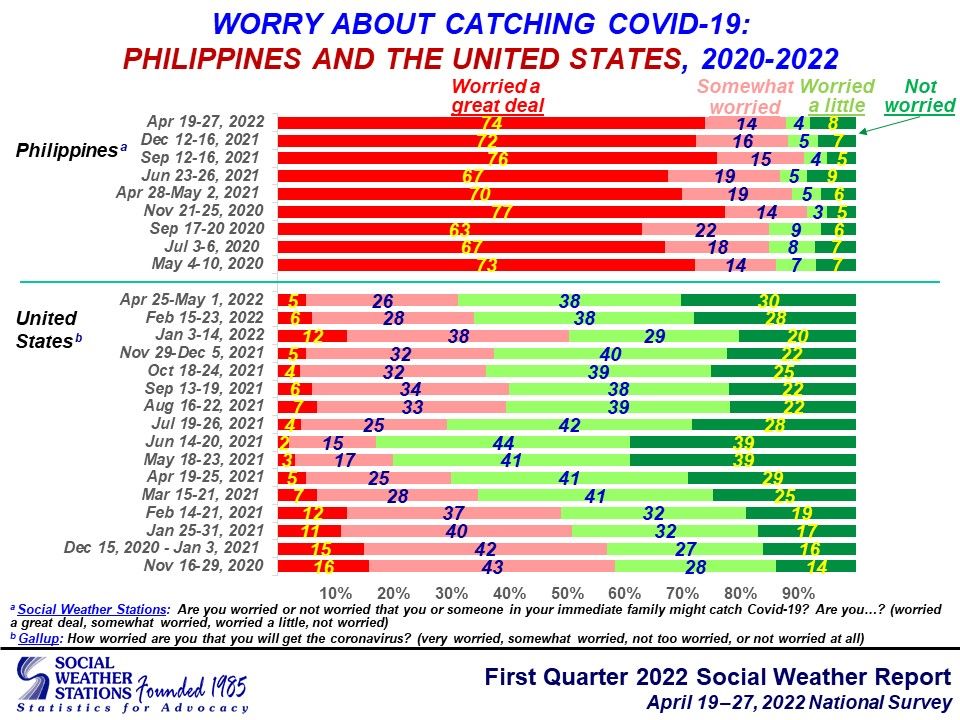
If you liked what you just read and want more of Our Brew, subscribe to get notified. Just enter your email below.


Related Posts
Social Weather Report | 59% Knew of VP Sara Duterte’s Fourth Impeachment Case Before the Survey; 41% Learned Only During the Interview
Jul 09, 2025
Supreme Court Rules Trump Can Rapidly Deport Immigrants to Libya, South Sudan and Other Countries They Aren’t From
Jun 25, 2025
Israel, Iran and the US: Why 2025 is a Turning Point for the International Order
Jun 19, 2025